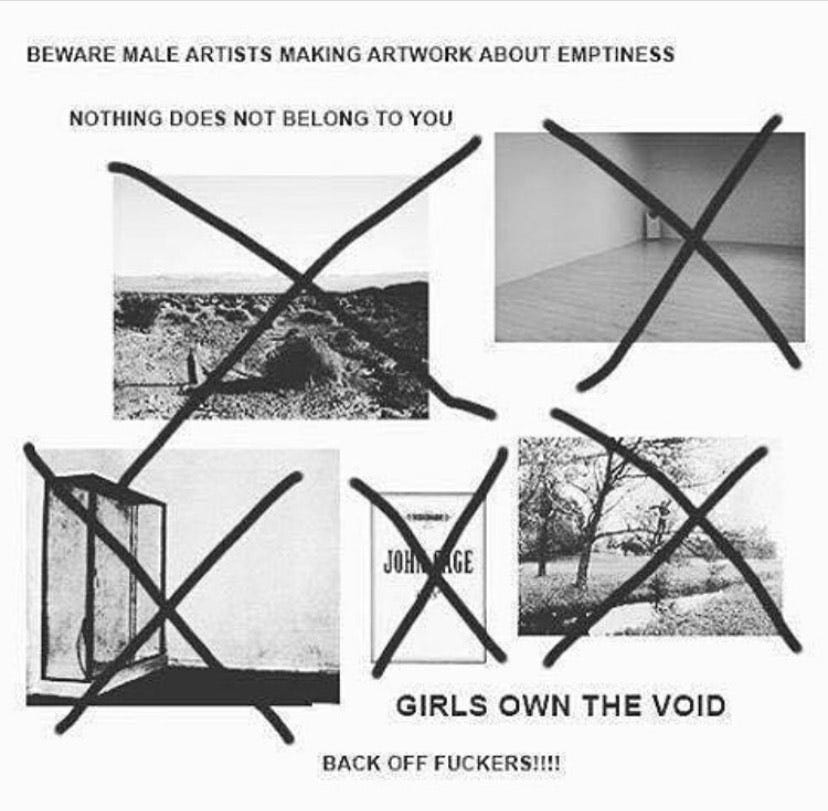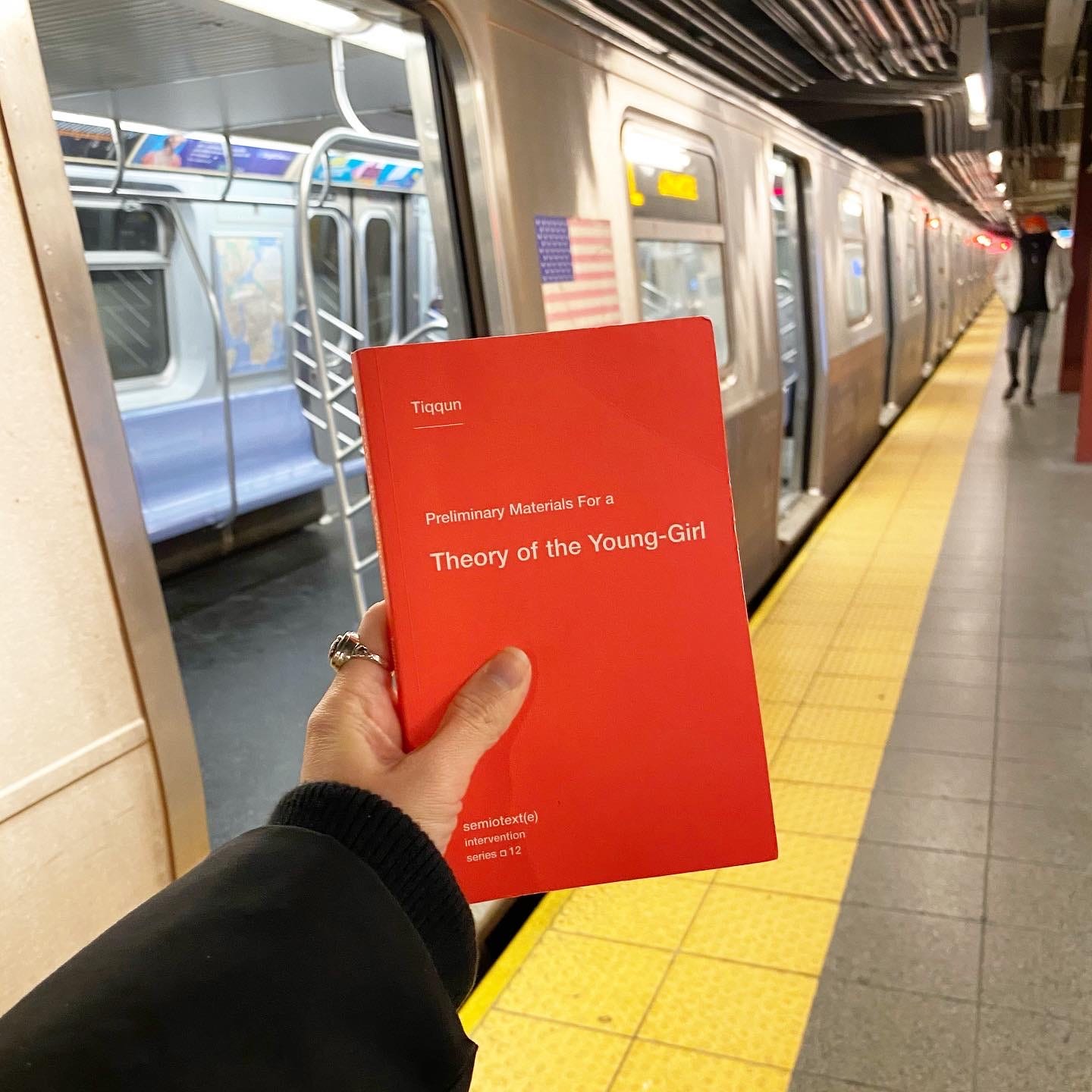Preliminary Materials For a Theory of the Young-Girl by Tiqqun
girls, girls, girls!
Hi y’all,
I’m back again, reading nonfiction. Just a quick disclaimer that I am extremely new to reading any sort of theory (outside of an undergraduate academic setting), so I welcome any advice and gentle corrections to misreadings. You’re also invited to fight me, if you want. But there’s really no need.
Here’s a link to purchase the book.1
Preliminary Materials for A Theory of the Young-Girl is pretty fun. It’s pithy, it’s quotable, and includes many moments in which you’ll see yourself and cringe. The most exciting (and horrifying) thing about this book is that it really anticipates influencer culture. Seriously, as I read, I became a little sick with myself, my personal Instagram, and even this blog.2
Tiqqun (an anonymous group of French intellectuals in the late-90s/early-00s) begins by telling us that the Young-Girl is not a gendered concept. The Young-Girl might have begun as a state primarily embodied by young girls, but now, everyone (regardless of gender) is a Young-Girl. A Young-Girl is a person who looses all selfhood and becomes a “model citizen as redefined by consumer society.”
Listen: The Young-Girl is obviously not a gendered concept… In reality, the Young-Girl is simply the model citizen as redefined by consumer society since World War I, in explicit response to the revolutionary menace. …Faced with the challenge of socialism, capital too would have to socialize. It had to create its own culture, its own leisure, medicine, urbanism, sentimental education and its own mores, as well as a disposition toward perpetual renewal.
Your initial reaction might be to yawn. Nothing really new after all. But the fun of the book comes in the form and the prose—Preliminary Materials reads like a zine, offering up fragments (all in different fonts) of ideas, all in perfectly succinct little nuggets of seductive “wisdom.”
Okay first, it’s really wild to read this after spending months begging my friends to read Andrea Long Chu’s Females. They begin with a similar conceit, that “everyone is female.” But of course, they couldn’t be more different—in their use of this metaphor, in their basic concerns, but also in affect: Preliminary Theory seems to lack all hope and empathy, while Females seemed abundantly empathetic and, if not hopeful, tender.
Though Tiqqun claims that the Young-Girl isn’t gendered, it’s incredibly hard not to read it that way, and though some Young-Girl examples are clearly masculine, most are decidedly aimed at, well, young girls. Young girls who buy into it all—fashion, beauty, seduction & desire, and broadly, modern consumer capitalism. But then, Tiqqun goes beyond that: young girls (and Young-Girls) who try to escape the consumerist trap (by turning to Marxism or conservatism) are only sinking into a different form of Young-Girlhood.
There is nothing, neither poetry nor ethnology, neither Marxism nor metaphysics, that the Young-Girl cannot fit into the closed horizon of her vapid quotidian.
Immediately reminded me of the communists in Sally Rooney’s novels and Exciting Times by Naoise Dolan.
Their reasoning for choosing the young girl to be the Young-Girl: she is a member of both groups that are the ideal targets/stewards for a capitalism interested in forcing individuals to internalize its demands—young (who is solely a consumer, not working) and a woman (who reproduces and raises children). Fine. Fair enough, nothing new. But reading Preliminary Materials, the style intensely reminded me of a passage about the “Man Child” in Ben Lerner’s The Topeka School—the man child who is attached to his toys and his sodas. Why not use the Man Child? Doesn’t it get kinda boring to harp on teenage girls so much? Isn’t it a lil overdone,3 lazy?
As the translator Ariana Reines suggests in an article for Triple Canopy magazine, you can really wear yourself out debating if this is all just misogynistic drivel, or if we should take Tiqqun at their word that the Young-Girl really isn’t gendered at all. I think Reines is wise, and, besides, there are faults enough to wedge our fingers into without fruitlessly spinning our wheels about misogyny.
The Young-Girl is the void THEY maintain in order to hide the vividness of the void.

Preliminary Materials offers a pretty straightforward critique of liberal feminism vis a vis the pitfalls of consumerism. I’m not interested in defending liberal feminism (or “choice feminism”), nor am I the woman who is best suited to tear it down (though if you want a pretty good take down of libfem: this is the book for you). But I had a serious problem in this regard with Preliminary Materials:
There’s no redemption for the Young-Girl. There’s no escape. To be fair, Tiqqun never claims to offer that, noting “the jumble of fragments that follows does not in any way constitute a theory” and those who seek “moral comfort or vice in need of condemning” should search elsewhere. “It is less a question of converting Young-Girls than of mapping out the dark corners of the fractalized frontline of Young-Girlization… of furnishing arms for a struggle.”
But ultimately, I think this is kinda a lazy tack to take. It reminds me a bit of all the recent criticism of Sally Rooney and Jia Tolentino—self-awareness doesn’t absolve sin. Tiqqun would agree with this. But then they give us materials that can lend self-awareness, with no proposed roadmap amidst the rubble.
Generally, as a reader of fiction, I don’t typically expect (or want!) books to hand me all the answers. Am I asking too much of my theory? Maybe. I haven’t read enough to know for sure. You can let me know.
Maybe, what I’m really demanding is a little bit of hope (a little bit of “moral comfort”), which, I also demand of fiction (see my review of Fraternity, handily republished on my Substack!). I’m not sure what my demand for hope and redemption is the hangover of (remnants of my Catholic upbringing? a contrarian reaction to these very cynical, ironic times? the lingering effect of reading too many fantasy novels as a child?) and a nagging, disillusioned voice in my head tells me it’s naive.4 Maybe it is just a symptom of Young-Girlhood.
The Young-Girl prizes “sincerity,” “good-heartedness,” “kindness,” “simplicity,” “frankness,” “modesty,” and in general all the virtues which, considered unilaterally, are synonymous with servitude. The Young-Girl lives in the illusion that liberty is found at the end of total submission to market “Advertising.” But at the end of servitude there is nothing but old age and death.
And:
Identical in this to the alienated social whole, the Young-Girl hates sorrow because sorrow condemns her just as it condemns this society.
Next week I’ll be writing even more about Tiqqun (more specifically, how I think the Young-Girl uses TikTok and other social media), so I hope everyone is as perversely interested in this as I am. [Edit: Here’s a link for those interested!]
And for more of my reviews, and general musings about books, you can subscribe here:
Or read a few of my favorite posts, including:
A plan for the perfect celebrity book club, designed for my muse, Sydney Sweeney
My review of Allie Rowbottom’s Aesthetica
My review of Olga Ravn’s The Employees
xoxo,
Book Notes
PS. Ariana Grande is definitely the voice of the Young-Girl.
FYI: As an affiliate of BookShop, I’ll earn a commission if you purchase through this link.
A couple quotes below that hit me particularly hard in this regard (ie: Instagram):
The Young-Girl never creates anything; All in all, she only recreates herself.
The Young-Girl requires not only that you protect her, she also wants the power to educate you.
When the Young-Girl gives into her own insignificance, she still manages to find glory in it, because she is “having fun.”
The Young-Girl exists only in proportion to the desire THEY have for her, and knows herself only by what THEY say she is.
And here are a few quotes that hit close to home on a personal level:
It is enough to recall what she classifies as “adventure” to get a good idea of how much the Young-Girl fears the possible.
The Young-Girl adopts above all the point of view of psychology, about herself as much as the course of the world. This is how she manages to present a certain consciousness of her own reification, a consciousness that is itself reified, as it’s cut off from all gesture. [ed note: is this also a self-own on behalf of this book? Maybe]
Okay, this was originally published in 1999. BUT: dunking on teenage girls has a long, illustrious history.
Genius-level translator Ariana Reines speaks to something similar in her translator’s note in Triple Canopy, and you really should go ahead and read that, because really, she says it all better and more fully. I wrote most of this review before reading her note, and was glad to find us aligned in our readings. I was sad to find out that my own review is but a pale shade of her wonderful writing!




Wow, you were right! I do not like this Young-Girl idea. I don't really understand how you can gender something so outright, and then say, no, this isn't criticizing a gender. But I'm just a girl, what do I know?
Also, I feel you on the wanting some sort of "hope" when you're reading something that is meant to provide some sort of understanding of the world. I feel the same with scientific papers. If the whole thing is just doom and gloom, listing bad thing after bad thing, what really is the point? Why put so much effort in outlining all these problems if you're not going to offer some sort of solution? I may have drifted far from the Young-Girl theory, but basically, I think wanting an upside or solution is a valid criticism.
Loving the substack format! Keep it up :) Also loving the Ariana video ;)
Great post. Reminds me of this film analysis of the "woman child" trope and comparing it with the pervasive "man child" trope. I wonder if the points raised in this book (Young-Girl is center of capitalist culture) help explain why we find it so natural to want to avoid growing up or stay "Young-Girl" into adulthood. I also think that looking at this through the film medium does provide a bit more "hope" or "redemption" than what was described in the book, but misses some of the interesting takes on ideology (loved the void image btw). https://www.youtube.com/watch?v=KD1eOBBhEmk